| |
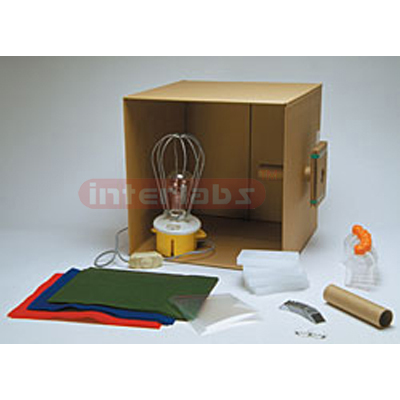 Click to Enlarge
Click to Enlarge
|
Spectrum Projector (LSE)
| Spectrum Projector Experience a clear and bright projected spectrum in a room that cannot be completely darkened and demonstrate the changing color of an incandescent object as its temperature changes with simple equipment. The spectrum projector includes all of the materials necessary to build a device that will produce a diffracted beam of light in two directions (two lab setups in one). A dimmer allows students to vary the temperature and brightness of an incandescent light bulb to study how the spectrum changes. A paraffin spectrum analyzer will show the students a bar graph of the projected spectrum. They can experiment with how objects of different colors appear in different colors of light. The kit contains: 2 squares of diffraction grating |
• 2 cardboard tubes
• 2 collimated lenses (53mm diameter)
• 1 200-watt clear light bulb
• 1 socket with dimmer, lampholder cage, and power cord (assembly required)
• 1 set of paraffin blocks
• 1 set of small mirrors
• 6 bottles
• red, blue, and green felt (2 sheets of each)
• 4 filter sheets (6" x 6")
• 1 set of instructions |
See Enlarge
|
|
|
|
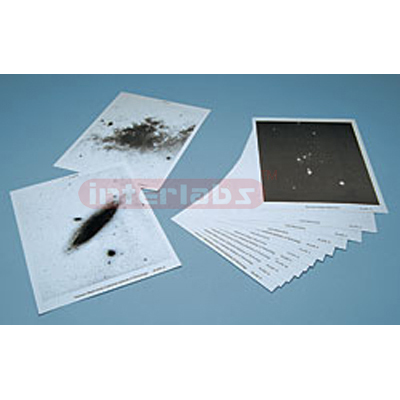 Click to Enlarge
Click to Enlarge
|
Sky Survey, 14 Plate Sert with Key (LSE)
14 Plate Set with Key These photographs from the Harvard College Observatory plate stacks, the Lick Observatory Sky Survey, and the Palomar Sky Survey (1950) are high-quality reproductions of regions of the sky with stars, nebulae, and galaxies. A complete key is included for identification. Activities include the effect of the focal length of a telescope on image size, and estimating the distances to two galaxies by comparing images taken by the same telescope and the identification of deep sky objects. One set could be ordered for each student to accompany the activity book, Where We Are in Space and Time, or a few sets could be ordered by the teacher for use in the classroom.
See Enlarge
|
|
|
|
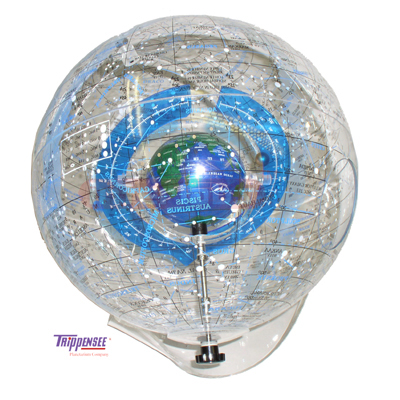 Click to Enlarge
Click to Enlarge
|
Celestial Globe, 16 (LSE)
| This 16" diameter clear acrylic celestial globe is unique in many features that place it far above other such globes. All of the stars are printed on the inside of the globe so that your eyes are drawn to the yellow dots (representing the stars) on the far side of the globe. This unique feature enables the viewer to see the stars, constellations, and other celestial objects in the same left right orientation that they appear in the night sky. Clear printing in four colors is helpful in reading the information on the globe. Star dots were specifically designed to be significantly different in size so that they are easily determined without the aid of measurements. |
| |
| A 5-3/4" transparent acrylic Earth ball inside the sphere assists in orienting the viewer who is located on the Earth. A yellow sun ball moves 360° along the ecliptic to set the date when using the globe. The blue horizon ring is large enough and close enough to the celestial sphere to assist in delineating the area of the star field that can be seen from any location on the earth on any date and any time. |
| |
| The Explorer Celestial Globe is not only highly educational, but also an attractive display piece for any home or office. This globe has been in production by Trippensee for over 30 years. An extensive instruction book, Trippensee Transparent Celestial Globes, is included with this model. Shipping weight 30lbs (oversize). |
See Enlarge
|
|
|
|
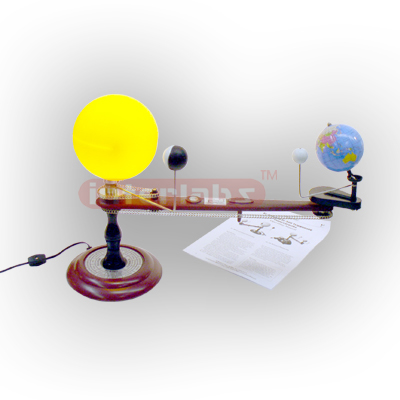 Click to Enlarge
Click to Enlarge
|
Original Trippensee Planetarium (LSE)
| The Trippensee® planetarium (EL- 400) and the motorized Trippensee® planetarium (EL- 500) are orreries that perform the same functions; the difference being that the motorized model contains a spring wire connection to the red arm which moves the planetarium arm to revolve the Earth, moon, and Venus balls around the sun. These planetariums are durable and reliable gear and ladder chain driven so that the Earth maintains it’s 23-1/2° axis, revolves around the sun and rotates on it’s axis, all at the same time. The moon revolves around the Earth and keeps it’s one face toward the Earth. Venus also revolves around the sun, and can be positioned by hand, as well, to show phases and where it is located as the morning or evening star. |
| |
Among the phenomena which the models show are the following:
Phases of the moon
Eclipses of the sun and moon
Causes of night and day
Seasons in various parts of the Earth
Reasons for winter and summer
What the solstices and equinoxes are
The axis of the Earth and its relationship to the North Star
About the tides and their causes
The Earth’s equator, latitude, longitude and meridians |
| |
| The Trippensee models have been produced for over 90 years and provide many visual demonstrations that clarify the relationships of these elements of the solar system, in motion, for children and adults interested in learning more about the universe around them. The chain and gear drives on this model provide an exceptionally long life for the product and provide a model that is unequaled in the marketplace today. An instruction book, Elements of Astronomy and Physical Geography, is included. |
| |
Height: 14" Arm length: 16 1/2"
Sun: 5 3/4" Earth: 3"
Globe color: Light blue or black oceans (may vary from picture) |
| EL-401 requires 12 volt DC power supply |
See Enlarge
|
|
|
|
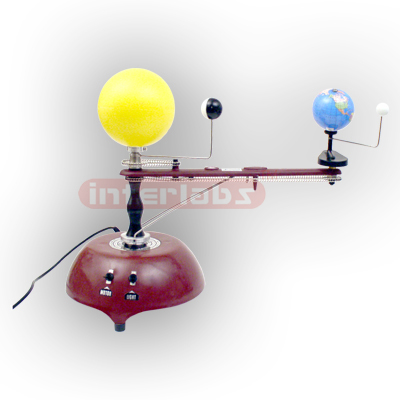 Click to Enlarge
Click to Enlarge
|
Motorized Trippensee Planetarium (LSE)
| The Trippensee® planetarium (EL- 400) and the motorized Trippensee® planetarium (EL- 500) are orreries that perform the same functions; the difference being that the motorized model contains a spring wire connection to the red arm which moves the planetarium arm to revolve the Earth, moon, and Venus balls around the sun. These planetariums are durable and reliable gear and ladder chain driven so that the Earth maintains it’s 23-1/2° axis, revolves around the sun and rotates on it’s axis, all at the same time. The moon revolves around the Earth and keeps it’s one face toward the Earth. Venus also revolves around the sun, and can be positioned by hand, as well, to show phases and where it is located as the morning or evening star. |
| |
Among the phenomena which the models show are the following:
Phases of the moon
Eclipses of the sun and moon
Causes of night and day
Seasons in various parts of the Earth
Reasons for winter and summer
What the solstices and equinoxes are
The axis of the Earth and its relationship to the North Star
About the tides and their causes
The Earth’s equator, latitude, longitude and meridians |
| |
The Trippensee models have been produced for over 90 years and provide many visual demonstrations that clarify the relationships of these elements of the solar system, in motion, for children and adults interested in learning more about the universe around them. The chain and gear drives on this model provide an exceptionally long life for the product and provide a model that is unequaled in the marketplace today. An instruction book, Elements of Astronomy and Physical Geography, is included. |
| |
Height: 14". Arm length: 16 1/2"
Sun: 5 3/4" Earth: 3"
Globe color: Light blue or black oceans (may vary from picture) |
See Enlarge
|
|
|
|
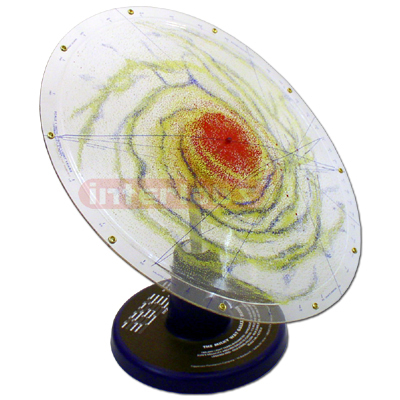 Click to Enlarge
Click to Enlarge
|
Milky Way Model (LSE)
| The Milky Way model is helpful in visualizing the shape of our galaxy, and also our place within it. It shows the shape of the galaxy, the distribution of clusters of stars spiral arms, and other related celestial objects within a coordinate system. |
| |
| The importance of this model is to provide a visual concept of the galaxy in which our Earth is located as well as to provide some information regarding other objects within it. |
| |
| As with all of the models produced by Trippensee Planetarium Co., Trippensee’s 90 years of producing models for educators has led to a series of products which are designed to last for many, many years, and which are made to be handled and used. An instruction book, The Milky Way Galaxy Model, is included with this model. Shipping weight 5lbs. |
See Enlarge
|
|
|
|
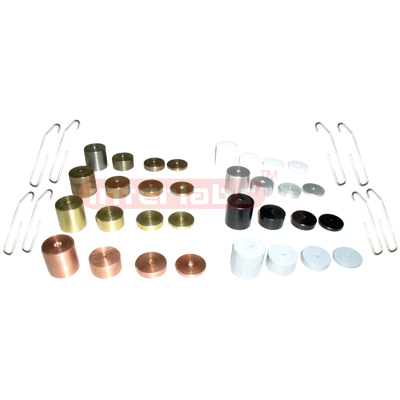 Click to Enlarge
Click to Enlarge
|
Density of Solids Cylinders Set (LSE)
| Use this set to determine the specific gravity of a material by graphical methods. |
| |
| • The set consists of four (4) samples of each of eight different materials, arranged in a binary weighting sequence, with each weight double its predecessor (1/8, 1/4, 1/2 and 1” long). This means that 15 individual determinations of specific gravity can be made. These results are plotted on a graph, the slope of which is the specific gravity of the material. |
| |
| • Includes: Eight (8) different materials in sets of four (4) masses; sturdy weight hanger that can be used for all samples; instructions with worksheets by Dr. A.Z.M. Ismail, PhD. Materials include aluminum, copper, delrin (black), bronze, brass, teflon (white), PVC (grey) and stainless steel. |
See Enlarge
|
|
|
|
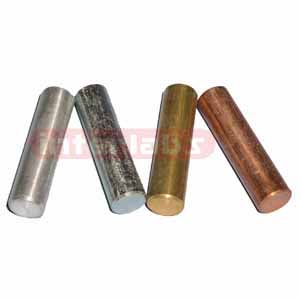 Click to Enlarge
Click to Enlarge
|
Metal Specimens Set (LSE)
| Use this handy set to measure density after the student has determined the mass and volume of each. Consists of 4 metal cylinders, each 50 mm long and 13 mm in diameter, with precision-machined ends for accuracy of measurement. |
| |
• Fits in graduated cylinders
• Can be used to teach measurement |
See Enlarge
|
|
|
|
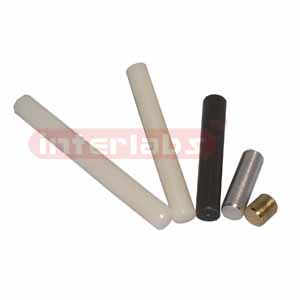 Click to Enlarge
Click to Enlarge
|
Equal Mass Set (LSE)
This convenient 5-piece set demonstrates the inverse relationship between density and length for cylinders of the same mass and diameter. Includes: 5 machine-turned specimens with the same diameter (12 mm) but varying lengths. Also includes instructions with lab activities.
See Enlarge
|
|
|
|
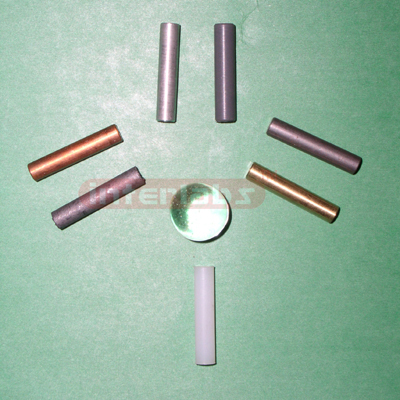 Click to Enlarge
Click to Enlarge
|
Specific Gravity Set (LSE)
Nine different materials about 1 cc in volume that range in density from .05 to 19 g/ml. Use for student density experiments, large enough for young fingers to handle. Instructions.
See Enlarge
|
|
|
|
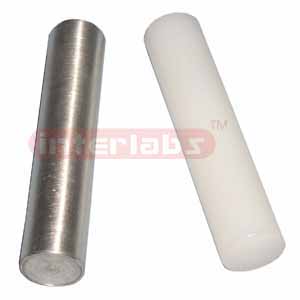 Click to Enlarge
Click to Enlarge
|
Density Rod Kits (LSE)
| 30-160 Density Rod: What floats in cold water, sinks in hot? Our precisely calibrated cylinder - that's what! It demonstrates the differing density of a liquid at different temperatures. Illustrated instructions. Consists of a durable hollow aluminum cylinder (6.5 cm long and 1.9 cm in diameter) that fits most graduated cylinders. Instructions with experiments. Good for middle school. Wt: 3 oz. |
| |
| 30-162 Reverse Density Rod: Everyone knows water gets less dense as it gets warmer. Then why does this rod sink in cold yet float in less dense hot water? The answer lies in the fact that the density of the rod also changes with temperature. The rod becomes much less dense at higher temperatures. It wins the “race” against the heated water and floats, whereas the aluminum rod sinks.Contains: High-density polyethylene plastic rod, 1/2” in diameter, weighted and tested; instructions with theory. |
See Enlarge
|
|
|
|
 Click to Enlarge
Click to Enlarge
|
Mole Box (LSE)
| How to visualize what a mole of air really looks like? Use our custom-printed, die-cut cube... complete with mole! |
| |
| Many concepts in chemistry class are hard to grasp. (Plus we all need a good laugh.) This 6-sided cardboard box, each side 11.2" square, folds into a sturdy cube. Each side is imprinted with useful facts in large type that can be read easily across a classroom. |
See Enlarge
|
|
|
|
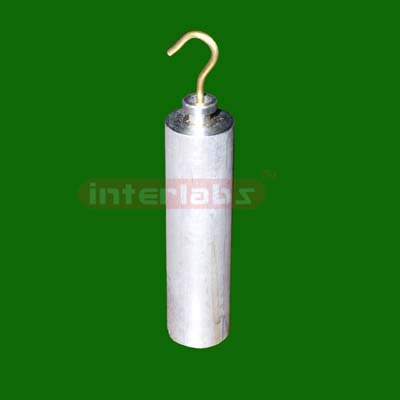 Click to Enlarge
Click to Enlarge
|
Aluminum Sinker (LSE)
What fits a graduated cylinder like a hand in a glove? Our aluminum sinker with hook.
This aluminum rod is the perfect size to fit your graduated cylinder. We include a handy brass hook to raise and lower it, when heated, with tongs.
Good price - many uses in lab. |
See Enlarge
|
|
|
|
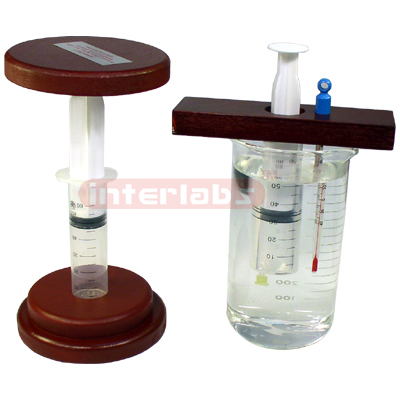 Click to Enlarge
Click to Enlarge
|
Gas Law Demonstrator (LSE)
| New! The discovery of the Gas Laws goes back aways - to 1662, to be exact. But it needn’t take a few centuries to understand the concepts. Despite the deceptive simplicity of our design, you can verify both Boyles’ Law and Charles Law to a high degree of accuracy. To prove it, we’ve provided sample data in our instructions. |
| |
| This set contains a syringe; two wood blocks for Boyles Law experiments; one wood block with two holes for performing Charles Law experiment. |
See Enlarge
|
|
|
|
|







